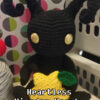Worsted… Weight…?
When you walk into a yarn store or the craft section of a department store you may become overwhelmed with the amazing selection of different yarn types. As you browse you can clearly see the different textures. Suddenly you realize your pattern mentions a certain weight… and you panic. What yarn do you get?
Are you working on a pattern? Check your pattern. Most patterns will tell you which type and weight your yarn should be. Since you’ll be following me to the end of this whole thing let’s use my free owl pattern available at the end of the lesson. Under materials at the top, it states Worsted Weight yarn, followed by colors used.
Worsted Weight yarn is the most commonly used weight for amigurumi. It’s a good thickness, it’s very common, and it comes in several colors that make it very easy to find exactly what you need. Below is a table of the other types of weight, their symbols, and the suggested hook sizes for each.

































Recent Comments